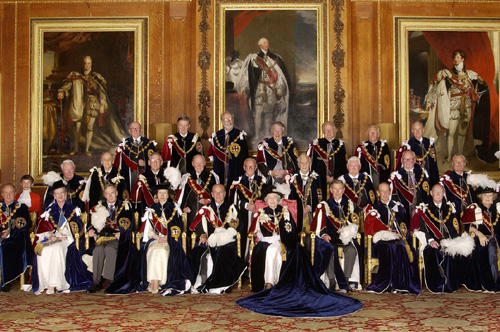April 29, 2007
·
answers, guests, math puzzles, The Mathcast
Lord Butler, Knight of the Garter, has never heard of the rule on last week’s show. But he notes he does move down the table each year…
When we posed this problem, we thought things would turn out a little differently, as we discuss here.
Permalink
April 23, 2007
·
math puzzles, The Mathcast

The twenty-five members of the Royal Order of the Garter, founded in 1348, by King Edward III, dine once each year at Windsor Castle, about a round table. From time immemorial, there has been a rule that no two members may be seated next to one another more than once each decade. But can they do better?
Permalink
April 15, 2007
·
answers, Favorites, guests, infinity, logic, Mathfactor Events, numbers, paradoxes, The Mathcast
A contestant for our Million-Dollar-Give-Away sent in Rayo’s Number, hitherto the largest number ever used for any real purpose: to wit, winning the
LARGE NUMBER CHAMPIONSHIP

Check out the article by Scot Aaronson that inspired them to duke it out! And this thread on the math forum is quite interesting as well.
Permalink
April 13, 2007
·
answers, Follow Up, numbers, The Mathcast
Graham’s number, as huge as it is, can be “described” or “named” in a very few symbols. Several people sent us programs that (in principle!) calculate Graham’s number— you can think of any of these programs as notation for Graham’s number.
Read the rest of this entry »
Permalink
April 2, 2007
·
answers, numbers, Q&A
We never did resolve the question of which grows faster:
In this corner we have
Sequence 1 n^^n
1, 2^2, 3^3^3, 4^4^4^4, and so on.
And over here we have Sequence 2, defined recursively by
The first entry is 1
the next entry is 2, followed by one (the previous entry) factorial sign; 2!=2
the next entry is 3, followed by two (the previous entry) factorial signs; 3!! = 6! = 720
4, followed by 720 factorial signs, which is a truly staggering number.
5 followed by whatever-the-previous-entry was number of factorial signs, etc.
In short, we can define the second sequence as s(1) = 1; s(n) = n, followed by s(n-1) factorial signs.
Which sequence grows faster than the other??
We have many conflicting answers, and no decisive resolution; here was one idea .
Permalink
April 1, 2007
·
numbers, paradoxes, The Mathcast
Our minds boggle as we continue our quest! This week we discuss the Knuth Arrow notation, for describing some really staggeringly large numbers. And yet we are still two weeks from talking about the largest number ever used for any real purpose!
We also discuss an April Fool’s paradox! Last week we said there were three errors on the Math Factor. But there were only two, so this announcement was one of the three errors! But then the announcement was correct! ETC.
Permalink
March 24, 2007
·
errata, math puzzles, numbers, The Mathcast
We’re well on our way towards describing the two largest numbers that have ever been used! Unfortunately, there are at least three errors in this segment of the Math Factor–can you spot them all?
Permalink
March 20, 2007
·
numbers, Q&A
David R. of Palo Alto writes:
Have you ever discussed factorials on your podcast? I don’t recall,
but a friend and I are puzzled and so of course we turn to you: Why
is “zero factorial” 1? Was it simply defined that way to frustrate
all of us nonmath folks, or is there a valid explanation?
Read the rest of this entry »
Permalink
March 19, 2007
·
Favorites, game theory, math puzzles, Mathfactor Events, numbers, The Mathcast
We discuss the results of the fabulous Math Factor Million Dollar Giveaway. and confess this was an excuse to bring up Game Theory and how to talk about really big numbers.
Permalink



 mathbun.com
mathbun.com